Abstract
Students with intellectual disabilities can learn to read. There are three basic approaches to reading instruction with this population: (a) a sight word approach, (b) a phonics or skills-based approach, and (c) a comprehensive approach. Of these, only the comprehensive approach will enable students to achieve their full literacy potential. This article describes a comprehensive, meaning-based approach. The meaning-based approach is based on a neurocognitive model of reading. This model describes reading as a process of creating meaning with print in which the brain uses three cueing systems to recognize words (phonological, semantic, and syntactic). Reading instruction for students should be balanced and comprehensive, using authentic or connected text to emphasize reading as a meaning-making endeavor. This is not a program or method; rather, a set of research-based strategies designed to develop all three of the brain’s cueing systems. The author describes six different types of strategies used with this approach: (a) writing, (b) word work, (c) cloze and maze, (d) fluency activities, (e) comprehension, and (f) self-selected reading practice. Teachers are encouraged to adopt and adapt based on the needs of their students; however, it is recommended that strategies from all six categories be used for daily reading instruction
Keywords: Intellectual disabilitiesdevelopmental disabilitiesneurocognitivecueing systems
Introduction
It was once thought that students with intellectual disabilities were not capable of learning to read (Erickson, 2006). As such, they were provided little or no reading instruction and had few opportunities to engage in authentic literacy activities (Coyne, Pish, Dalton, Zeph, & Smith, 2012; Katims, 2000). The reading instruction that did occur, was not very effective. It should not be surprising then to discover that today, many adults with intellectual disabilities are illiterate or under-literate (below their capabilities). This severely impacts their employment opportunities as well as their ability to participate fully in society (Browder, Wakeman, Spooner, Ahlgrim-Delzell, & Algozinne, 2006: Erickson, 2006). This article describes an effective, research-based approach to reading instruction for students with intellectual disabilities that is based on the neurocognitive model of reading.
Problem Statement
Approaches to Reading Instruction
Sight Word Instruction
In the past, most reading instruction for students with intellectual disabilities consisted primarily of sight word instruction (Browder, Ahlgrim-Delzell, Courtake, Gibbs, & Flowers, 2008; Katims, 2000; Hill 2016; Hudson & Test, 2011). Sight word instruction in this context consisted of asking students to memorize a set of functional (sometimes called survival) words, pictures, and symbols. These were words such as: danger, hot, exit, flammable, exit, boys, girls, poison, etc. However, there is very little (if any) empirical evidence supporting a purely sight-word approach to reading instruction for any population. Here, students do not learn to generalize or to identify new words beyond those memorized. Thus, sight word instruction should not be used for reading instruction for students with intellectual disabilities (Browder, Ahlgrim-Delzell, Courtake, Gibbs, & Flowers, 2008; Erickson, Hanser, Hatch, & Sanders, 2009; Fautsch-Patridge, McMaster, & Hupp, 2011; Schwarts, Hahs-Vaugh, & Nye, 2013).
Phonics Instruction
More recently, research has shown that students with intellectual disabilities benefit from phonics instruction (Allor, Mathes, Roberts, Cheatham & Al Otaiba, 2014; Alnahdi, 2015; Fautsch-Patridge, McMaster, & Hupp, 2011; Fredrick, Davis, Albert, & Waugh, 2013; Hill, 2016). That is, they can learn to generalize and apply these skills in other contexts in order to identify unknown words (Browder, Ahlgrim-Delzell, Courtake, Gibbs, & Flowers, 2008; Browder, Ahlgrim-Delzell, Flowers, & Baker, 2012; Erickson, Hanser, Hatch, & Sanders, 2009; Erickson & Koppenhaver, 1995; Scruggs, 2008). However, what often occurs in special education settings is that this becomes the primary focus (Hill, 2016; Katims, 2000). That is, reading instruction is reduced to drill and practice with a highly abstract set of reading subskills, taught using direct instruction, and decontextualized from any real meaning (Coyne, Pish, Dalton, Zeph, & Smith, 2012; Erickson, Hanser, Hatch, & Sanders, 2009; Hedrick, Katims, & Carr, 1999; Katims, 2000). Here there is little (if any) focus on creating meaning with print (comprehending). As well, students are rarely provided opportunities to do what is most important in becoming literate: read authentic text and write for real purposes (Allington, 2012; Pressley et al., 2001).
Research Questions
While research has shown that phonics-based instruction can lead to increased scores on phonics-based measures (Allor, Mathes, Roberts, Cheatham, & Al Otaiba, 2014; Browder, Ahlgrim-Delzell, Flowers, & Baker, 2012; Fautsch-Patridge, McMaster, & Hupp, 2011; Fredrick, Davis, Albert, & Waugh, 2013, Hill, 2016); there is little evidence to demonstrate that this type instruction has any have long term effect on students’ ability to create meaning with print (Allington, 2012; Johannessen & McCann, 2009; McCormick, 2007; Strauss, 2011). And with this approach to reading instruction, reading becomes an abstract and meaningless endeavor for a population that needs learning experiences to be concrete and immediate. Phonics instruction is necessary; however, it should not be the primary component of a reading program for students with intellectual disabilities (Erickson, Hanser, Hatch, & Sanders, 2009; McCormick & Zutell, 2011; NICHD, 2000). Instead, reading instruction should be balanced and comprehensive, using authentic or connected text to emphasize reading as a meaning-making endeavor (Coyne, Pish, Dalton, Zeph, & Smith, 2012; Erickson, 2006; Erickson & Koppenhaver, 1995; Hendrick, Katims, & Carr, 1999; Hudson & Test, 2011; Katims, 2000).
Purpose of the Study
This article describes a comprehensive, meaning-based approach based on a neurocognitive model of reading and six types of strategies used for its implementation.
Research Methods
The author uses text analysis and comparative analysis for the research.
Findings
A Comprehensive, Meaning-Based Approach
The meaning-based approach recommended here is based on a neurocognitive model of reading. This model describes reading as a process of creating meaning with print in which the brain uses three cueing systems to recognize words (phonological, semantic, and syntactic) (Anderson, 2013; Hruby & Goswami, 2013; Johnson, 2016; Paulson & Freeman, 2003; Ruddell & Unrau, 2013; Straus, 2011; Weaver, 2009). It is not a program or method; rather, a set of research-based strategies designed to develop all three cueing systems. There are six different types of strategies used here: (a) writing, (b) word work, (c) cloze and maze, (d) fluency activities, (e) comprehension, and (f) self-selected reading practice. Teachers are encouraged to adopt and adapt based on the needs of their students; however, it is recommended that strategies from all six categories be used for daily reading instruction.
Writing
Writing. Every reading interventional session should include some form of writing activity (Johnson, 2017). Reading and writing strengthen each other (Duke, Pearson, Strachan, & Billman, 2011; Goodman, Fries, & Strauss, 2016; Lipson & Wixon, 2009; Parodi, 2013; Weaver, 2009). As well, writing is one of the most effective strategies to use to develop the syntactic cueing system (Johnson, 2017). It also strengthens letter-sound relationships. Below are examples of the types of writing activities that could be used here.
Language experience activities (LEA). Here students dictate three to five sentences to create a paragraph. The teacher writes what students say on a screen, board, poster, or paper. Then, students re-read the paragraph until fluency is achieved. Finally, the paragraph is used for an analytic phonics mini-lesson.
Sentence mix-up. Students create meaning by reordering the words in a mixed-up sentence. Initial sentences can be taken from the LEA above, written on a strip of paper, with each individual word cut out. Sentences can also be taken from stories students are reading.
Predictable writing. Three sentences are written with one word missing (see Figure
01 ). Working in small group, create a large poster and have each student fill in one line. Then students should re-read the sentences until fluency is achieved (Johnson, 2017).
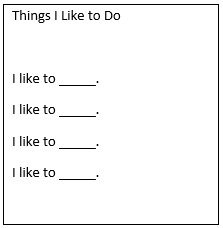
-
One sentence ; It is easy for some students to become overwhelmed with the task of writing. With these students, it is often best to start by asking them to write a single sentence. If they are not used to writing, you may have to help them identify possible topics by asking questions such as those in Figure02 (Johnson, 2017).
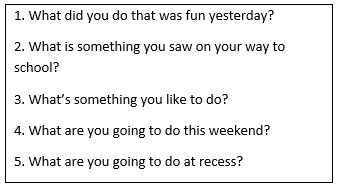
-
Syntax sentences. Students are shown two to three sentence that contain syntax errors (grammar or word order). Read them aloud first, then ask students to make corrections. These sentences can be designed to reinforce target letters or letter patterns or to use as pre-reading and post-reading activities.
-
Sentence combing. Ask students to combine two sentences while retaining the meaning of both.
-
Sentence alteration. Students are given a sentence and asked to say the same thing using different words or a different word order (see Figure
03 , (Johnson, 2017)).
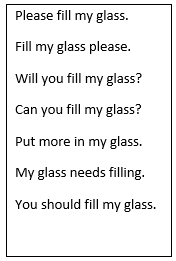
-
Sentence elaboration. Students are given a single sentence and asked to make it different or more interesting (see Figure04 ).
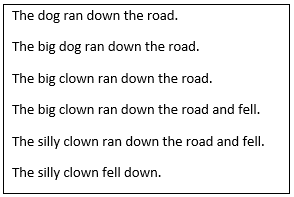
The writing activities like sentence elaboration, alteration, and combining can be done orally or in writing. Again, since the focus is on grammar and word order, the teacher can use all the activities above to develop the syntactic cueing system (Johnson, 2017). They can also be used to reinforce letter sounds or patterns. These activities should be kept simple and brief.
Word Work
The goal of word work is to strengthen letter-sound relationships and enhance students’ ability to see letter patterns (Cunningham & Cunningham, 2002; Erickson & Kopenhaver, 1995). Word work should be one part of any instructional program for reading (Johnson, 2017). It is recommended that these activities be based on common letter patterns or word families. Sometimes called large unit phonics or decoding by pattern, this focus helps to develop students’ ability to identify words by analogy (Allington, 2002; Cunningham & Cunningham, 2002). Five types of activities are described here:
Word-building. This is a large unit phonics activities that enhances students’ ability to recognize letter patterns and word parts or phonograms. An initial letter sound and a word part or phonogram can be given to students. They are asked to put them together to create a ward.
Word discrimination. This activity allows students to develop their ability to recognize target letter patterns within words. Here, two words are presented, one of which has the target letter pattern. Teacher asks students to quickly point to and read the word that contains the target letter pattern.
Which word looks right? Students are presented with two or three words that say the same thing phonetically, but only one of which is spelled correctly. Students are asked to identify the word that looks right (or correct). For example, students would be presented with the following spellings of the word ‘sail’ and asked which one looks right: sael – sail, or given the word ‘poke’ with the following choices: poce – poke -- poek.
Sentence dictation. The teacher or partner reads a simple sentence consisting of three to six words. The sentence should include at least one word with the target letter sound or pattern. Students write the sentence. After each sentence is written, students look for words that “do not look right” and underline them. Then the teacher shows students the complete sentence with correct spelling. They cross out the word and write the correct spelling on top. When the correct spellings are in place, students reread the sentence until fluency is achieved (Johnson, 2017).
Sentence replay (replay analysis). From three to five sentences on a piece of paper are shown to students. Each sentence contains at least one word with the target letter sound or pattern being reinforced. Students read the sentences into an audio recorder, then, they listen to the recording and underline miscued or stumbled words. They review the words and repeat the process until fluency is achieved with no miscues or stumbles (Johnson, 2017).
Cloze and maze activities.
Cloze and maze activities are used to develop the semantic cueing system (Johnson, 2017; Paulson & Freeman, 2003). Expert readers use context (semantics), background knowledge (schemata), syntax, along with minimal letter clues to create meaning with print (Binder, Duffy, & Rayner, 2001; Goodman, Fries, & Strauss, 2016; Hruby & Goswami, 2013; Paulson & Freeman, 2003; Weaver, 2009). As well, cloze and maze (semantics-based activities) have been used to enhance students’ reading fluency (Berends & Reitsma, 2004).
Cloze . Here, students read a sentence in which one word has just the beginning letter showing. They are asked to identify a word that makes sense within that sentence. The complete sentence is shown then to students and they are asked to re-read it until fluency is achieved (see Figure05 )
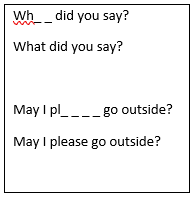
-
Maze. Maze activities provide students sentences containing three words from which to choose, and only one of them makes the sentence meaningful. For both cloze and maze, students should be shown six to ten sentences during a single session. Sentences can be designed to reinforce a target letter sound or letter pattern; they can also be designed to be used as pre- or post-reading activities.
Fluency Activities.
Being able to recognize words frees up space in short term memory for comprehension (Rasinski & Samuels, 2011). Repeated reading activities can be used as one of the methods toward this end (Kuhn & Stahl, 2013; Samuels, 2013). Through repeated practice with the same text, learners train to recognize words and process letter patterns quickly:
Words per half-minute (WPH). Students read a piece of text according to their reading level as quickly as they can for a half minute (Johnson, 2017). This is done three times with the number of words read recorded after each attempt. The student should read and pronounce as many words as possible in one minute not concerning about comprehension here or the number of words identified correctly. There are other places to measure these. You are just concerned about speed. Finally, students record their three WPM scores on a line or bar graph.
Short Passage Fluency (SPF). This is a repeated reading activity in which students should read a short passage of approximately 60 to 70 words. In each passage, the 30th, 40th, and 50th word is underlined or marked. They read the short passage three times and record their times on a line or bar graph. When students are able to read such part of the text at approximately 12 seconds, they move up to the next mark or reading level.
Scaffolded oral reading (ScORe). Scaffolded oral reading (ScORe) is a technique similar to the neurological impress method (Flood, Lapp, & Fisher, 2005). Here the teacher and the student read the text aloud. Teacher’s reading just a millisecond ahead of the student acts as a scaffold for a stable, comfortable rhythm. In case the student stops reading, the teacher goes on. The student rely on the teacher’s voice to act as a scaffold during reading in the following way: the teacher should read the text in a low voice and provide sufficient structure to support the rhythm of reading. If the student seems to read fluently, the teacher can just pronounce the first sounds of some words or dropping out of others completely. This kind of activity can be used alone or in small groups.
Cognitive Processes Related to Comprehension
Comprehension is thinking (Jennings, Caldwell, & Lerner, 2010; Paulson, Flurkey, Goodman, & Goodman, 2009). Some of the examples of the cognitive processes or operations used to comprehend are shown in Figure
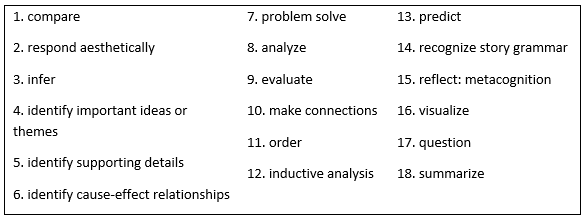
-
Story grammar. Narrative texts have similar structural elements including characters, setting, and events. Introducing some of the story grammar elements from the story as a pre-reading activity provides students with a scaffold or a sense of story structure before reading. Then, ask students to identify and record the missing story grammar elements as they are encountered in the story. This gets them reading purposefully.
-
Predicting. A prediction uses clues or background information to deduce what might happen next in a story. Good readers do this naturally. You can help student become a better predictor by stopping at a designated point in the story and asking a prediction question. Example: “What do you think will happen when …” Before making a prediction, student needs to remember at least two story clues and background information that he/she thinks are important. After a prediction is made, he/she should read to ahead to see if he/she was right.
-
Inference. Inferring is using information in the story or text to understand or conclude things not specifically stated. Good readers naturally do this. Like the prediction above, an inference must be based on known information or text clues. You can help students become better at inferring by stopping and asking an inference question. Students should list important clues or knowledge before identifying and describing their inference.
Self-Selected Reading Practice.
-
Reading practice. Reading practice should be one of the primary activities in any reading instructional program. Just like learning to play the piano, students need to practice reading every day if they are to get better. Extensive reading has been linked to improvement in general knowledge, vocabulary, spelling, fluency, word identification, and reading comprehension (Allington, 2012; Cunningham & Allington, 2010; Cunningham & Stanovich, 2001; Krashen, 2004). Thus, reading for enjoyment should be the main work of reading class. For this to occur, classroom libraries need to include an abundance of high quality books at varying levels that reflect a variety of interests. Students should always practice reading books that are at their independent level or below.
Conclusion
Some examples of the types of instructional strategies appropriate for students with intellectual disabilities are described in this article. Instruction for this group may include more repetition than students in a general education setting, and growth may occur more slowly; however, students with all levels of intellectual disabilities can reach their full literacy potential if they provided appropriate instruction. And just like other students, they learn best when reading instruction is provided in meaningful contexts and the focus is on creating meaning with print and not on mastering isolated reading subskills.
References
- Allington, R.L. (2002). Research on reading/learning interventions (pp. 261-290). In A. Farstrup and S.J. Samuels (Eds.). What research has to say about reading instruction (3rd ed). Newark, DE: International Reading Association
- Allington, R.l. (2012). What really matters for struggling readers: Designing research-based programs (3/e). Boston, MA: Pearson
- Almasi, J. F., Palmer, B. M., Madden, A., & Hart, S. (2001). Interventions to enhance narrative comprehension. In A. McGill-Franzen & R. Allington (Eds.), Handbook of reading disability research (pp. 329–344). New York, NY: Routledge.
- Allor, J.H., Mathes, P.G., Roberts, K., Cheatham, J.P. & Al Otaiba, S. (2014). Is scientifically based reading instruction effective for students with below-average IQs? Exceptional Children, 80(3), 287-306
- Alnahdi, G.H. (2015). Teaching reading for students with intellectual disabilities: A systematic review. International Education Studies, (8) 9, 79-87. Doi: 10.5539/ies.v8np79.
- Anderson, R. (2013). Role of the reader’s schema in comprehension, learning, and memory. In D. Alvermann, N.J. Unrau, & R.B. Ruddell (Eds.), Theoretical models and processes of reading (pp. 476-488). Newark, DE: International Reading Association.
- Berends, I.E. & Reitsma, P. (2004). Addressing semantics promotes the development of reading fluency. Applied Psycholinguistics, 27, 247-265.
- Binder, K. S., Duffy, S. A., & Rayner, K. (2001). The effects of thematic fit and discourse context on syntactic ambiguity resolution. Journal of Memory and Language, 44, 297–324.
- Browder, D.M., Ahlgrim-Delzell, L, Courtake, G., Gibbs, S.L., & Flowers, C. (2008). Evaluation of the effectiveness of an early literacy program for students with significant developmental disabilities. Exceptional Children, 75(1),
- Browder, D., Ahlgrim-Delzell, L., Flowers, C., & Baker, J. (2012). An evaluation of a multicomponent early literacy program for students with severe developmental disabilities. Remedial and Special Education, 33, 237-246.
- Browder, D.M. Wakeman, S.Y. Spooner, F., Algrim-Delzell, L. & Algozzine, B. (2006). Research on reading instruction for individuals with significant cognitive disabilities. Exceptional Children, 72(4), 392-408.
- Brown, A.L., Palinscar, A.S., & Armbruster, B.B. (2013). Instructing comprehension-fostering activities in interactive learning situations (pp 657-689). In D. Alvermann, N. Unrau, & R Ruddell (Eds). Theoretical models and processes of reading. Newark, DE: International Reading Association
- Coyne, P., Pish, b., Dalton, B., Zeph, L.A., & Smith, N.C. (2012). Literacy by design: A universal design for learning approach for students with significant intellectual disabilities. Remedial and Special Education, 33(3), 162-172.
- Cunningham, P.M. & Allington, R.L. (2010) Classrooms that work: They can all read and write (5th ed). Boston, MA: Pearson.
- Cunningham, P.M. & Cunningham, J.W. (2002). What we know about how to teach phonics (pp. 87-109). In A. Farstrup and S.J. Samuels (Eds.). What research has to say about reading instruction (3rd ed). Newark, DE: International Reading Association.
- Cunningham, A. E., & Stanovich, K. E. (2001). What reading does for the mind. Journal of Direct Instruction, 1, 137–149.
- Dole, J. A., Nokes, J. D., & Drits, D. (2009). Cognitive strategy instruction (pp. 347-373). In S. Israel & G. Duffy (Eds.), Handbook of research on reading comprehension. New York, NY: Routledge
- Duke, N.K., Pearson, P.D., Strachan, S.L., & Billman, A.K. (2011). Essential elements of fostering and teaching reading comprehension (pp 51-93). In S.J Samuels & A.E. Farstrup (Eds.). What research has to say about reading instruction (4th ed.). Newark, DE: International Reading Association
- Erickson, K. (2006). Literacy and persons with developmental disability: Why and how? Paper commissioned for the EFA Global Monitoring Report 2006, Literacy for Life.
- Erickson, K., Hanser, G., Hatch, P., & Sanders, E (2009). Research-based practices for creating access to the general curriculum in reading and literacy for students with significant intellectual disabilities (Final report to the Council of Chief State School Officers, Assessing Special Education Students, State Collaborative on Assessment and Student Standards). Chapter Hill, NC: Center for Literacy and Disabilities Studies. Retrieved from http://www.ncksec.net/docs/notices/certified/ELA_AAS_CLDS_-Final.PDF
- Erickson, K.A. & Koppenhaver, D.A. (1995). Developing a literacy program for children with severe disabilities. The Reading Teachers, 48(8), 676-684.
- Fautsch-Patridge, T., McMaster, K.L., & Hupp, S.C. (2011). Are current reading findings applicable to students with intellectual disabilities? In S.J. Samuels & A. Farstrup (Eds). What research has to say about reading instruction (4th ed.) Newark, DE: International Reading Association.
- Flood, J., Lapp, D., & Fisher, D. (2005). Neurological impress method plus. Reading Psychology an International Quarterly, 26(2), 147-160.
- Fredrick, L.D., Davis, D. H., Albert, P.S., & Waugh, R.E. (2013). From initial phonics to functional phonics: Teaching word-analysis skills to students with moderate intellectual disability. Education and Training in Autism and Developmental Disabilities (48(1), 49-66.
- Goodman, K.S., Fries, P.H., & Strauss, S.L. (2016). Reading the grand illusion: How and why people make sense of print. New York, NY: Routledge.
- Goodman, K.S. & Goodman, Y.M. (2009). Helping readers make sense of print: Research that supports a whole language pedagogy. In S. Esrael & G. Duffy (Eds). Handbook of research on reading comprehension. New York,NY: Routledge.
- Hedrick, W.B., Katims, D.S., & Carr, N.J. (1999). Implementing a multimethod, multilevel literacy program for students with mental retardation. Focus on Autism and Other Developmental Disabilities, 14(4), 231-239.
- Hill, D.R. (2016). Phonics based reading interventions for students with intellectual disability: A systematic literature review. Journal of Education and Training Studies 4(5), 205-214.
- Hruby, G.G. & Goswami, U. (2011). Neuroscience and reading: A review for reading education researchers. Reading Research Quarterly, 46(2), 156-172
- Hudson, M.E. & Test, D.W. (2011). Evaluating the evidence base of shared story reading to promote literacy for students with extensive support needs. Research and Practice for Person’s with Severe Disabilities, 36(1-2), 34-45.
- Jennings, J. H., Caldwell, J. S., & Lerner, J. W. (2010). Reading problems: Assessment and teaching strategies (6th ed.). Boston, MA: Allyn & Bacon.
- Johannessen, L.R. & McCann, T.M. (2009). Adolescents who struggle with literacy. (pp 65-79. In Christenbury, R. Bomer, and P. Smagorinsky’s (Eds.). Handbook of Adolescent Literacy Research. New York: Guildford Press.
- Johnson, A. (2016). 10 Essential instruction elements for students with reading difficulties: A brain-friendly approach. Thousand Oaks, CA: Corwin Publishing.
- Johnson, A. (2017). A meaning-based plan for addressing RTI for struggling readers. International Journal of Whole Schooling, 13(3), 88-107.
- Katims, D.S. (2000). Literacy instruction for people with mental retardation: Historical highlights and contemporary analysis. Education and Training in Mental Retardation and Developmental Disabilities, 35(1), 3-15.
- Krashen, S. D. (2004). The power of reading: Insights from research (2nd ed.). Portsmouth, NH: Heinemann.
- Kuhn, M.R. & Stahl, S.A. (2013). Fluency: Developmental and remedial practices – revisited (pp 385-411). In D. Alverman, N. J. Unrau, & R. B. Ruddell (Eds.), Theoretical models and process of reading, (6th ed). Newark, DE: International Reading Association.
- Learned, J.E., Stockdill, D., & Moje, E.B. (2013). Integrating reading strategies and knowledge building in adolescent literacy instruction (pp. 159-185). In S.J Samuels & A.E. Farstrup (Eds.). What research has to say about reading instruction (4th ed.). Newark, DE: International Reading Association.
- Lipson, M. Y., & Wixson, K. K. (2009). Assessment & instruction of reading and writing difficulties: An interactive approach (4th ed.). Boston, MA: Pearson.
- Martin, N. M, & Kuke, N. K. (2011). Interventions to enhance informational text comprehension (pp. 345-361). In A. McGill-Franzen & R. Allington (Eds.), Handbook of reading disability research. New York, NY: Routledge.
- McCormick, S. (2007). Instructing students who have literacy problems (4th ed.). Upper Saddle, NJ: Merrill/Prentice Hall.
- McCormick, S., & Zutell, J. (2011). Instructing students who have literacy problems (6th ed.). Boston, MA: Pearson.
- National Institute of Child Health and Human Development. (2000). Report of the National Reading Panel. Teaching children to read: An evidence-based assessment of the scientific research literature on reading and its implication for reading instruction (NIH Publication No. 00-4769). Washington, DC: U.S. Government Printing Office.
- Parodi, G. (2013). Reading-writing connections: Discourse-oriented research (pp. 957-977). In D. Alverman, N. J. Unrau, & R. B. Ruddell (Eds.), Theoretical models and process of reading. Newark, DE: International Reading Association.
- Paulson, E., Flurkey, A., Goodman, Y., & Goodman, K. (2003). Eye movements and miscue analysis: Reading from a constructivist perspective. The Fifty-Second Yearbook of the National Reading Conference, 52, 343-355
- Paulson, E.J. & Freeman, A.E. (2003). Insight from the eyes: The science of effective reading instruction. Portsmouth, NH: Heinemann.
- Pressley, M., Wharton-McDonald, R., Allington, R., Block, CC., Morrow, L., Tracey, D., Baker, K., Brooks, G., Cronin, J., Nelson, E., & Woo, D. (2001). A study of effective first-grade literacy instruction. Scientific Studies of Reading, 5, 35-58.
- Pressley, M., Wharton-MNcDonald, R., & Mistretta, J. (1998). Effective beginning literacy instruction: Dialectical, scaffolded and contextualized (pp. 357-373). In J. Metsala & L. Ehri (Eds.), Word recognition in beginning literacy. Mahwah, NJ: Erlbaum.
- Rasinski, T.V. & Samuels, S.J. (2011). Reading fluency: What it is and what it is not (pp 94-114). In S.J. Samuels and A.E. Farstrup’s (Eds.) What research has to say about reading instruction, (4th ed.). Newark, DE: International Reading Association.
- Rayner, K., & Well, A. D. (1996). Effects of contextual constraint on eye movements in reading: A further examination. Psychonomic Bulletin & Review, 3, 504–509.
- Ruddell, R., & Unrau, N. (2013). Reading as a motivated meaning-construction process: The reader, the text, and the teacher. In D. Alvermann, N.J. Unrau, & R.B. Ruddell (Eds.), Theoretical models and processes of reading (pp. 1015-1068). Newark, DE: International Reading Association.
- Samuels, S.J (2013). Toward a theory of automatic information processing reading, revisited (pp 698-718). In D. Alverman, N. J. Unrau, & R. B. Ruddell (Eds.), Theoretical models and process of reading Newark, DE: International Reading Association.
- Scruggs, A. (2008). Effective reading instruction strategies for students with significant cognitive disabilities Electronic journal for inclusive education, 2(8),1-12.
- Silliman, E.R. & Wilkinson, L.C. (1994). Discourse scaffold for classroom intervention (pp. 27-52). In G.P. Wallach & K.G. Butler (Eds.), Language learning disabilities in school-age children and adolescents. New York, NY: Merril/Macmillan.
- Strauss, S.L. (2011). Neuroscience and dyslexia (pp 79-90). In A. McGill-Franzen and R.L. Allington (Eds.), Handbook of reading disability research. New York: Routledge.
- Schwartz, J.B., Hahs-Vaugh, D.X., & Nye, C. (2013). Intervention program improves literacy skills for students with severe developmental disabilities. Evidence-based Communication Assessment and Intervention, 7(1), 31-35.
- Tompkins, (2011). Literacy in the early grades: A successful start for preK–4 readers and writers (3rd ed.). Boston, MA: Pearson
- Weaver, C. (2009). Reading process. Portsmouth, NH: Heinemann.
Copyright information

This work is licensed under a Creative Commons Attribution-NonCommercial-NoDerivatives 4.0 International License.
About this article
Publication Date
21 September 2018
Article Doi
eBook ISBN
978-1-80296-045-7
Publisher
Future Academy
Volume
46
Print ISBN (optional)
Edition Number
1st Edition
Pages
1-887
Subjects
Education, educational equipment, educational technology, computer-aided learning (CAL), Study skills, learning skills, ICT
Cite this article as:
Johnson, A. P. (2018). Reading Instruction For Students With Intellectual Disabilities. In S. K. Lo (Ed.), Education Environment for the Information Age, vol 46. European Proceedings of Social and Behavioural Sciences (pp. 266-276). Future Academy. https://doi.org/10.15405/epsbs.2018.09.02.31

